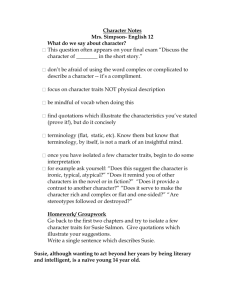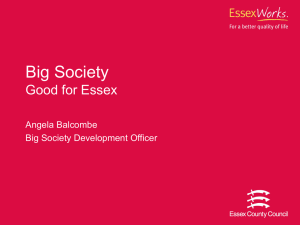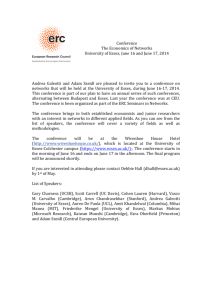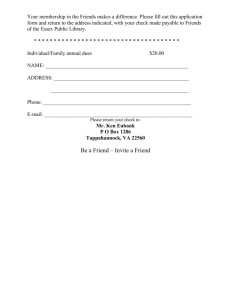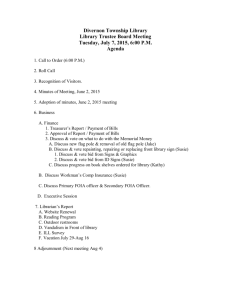Working with Denial - Signs of Safety Zeeland
advertisement
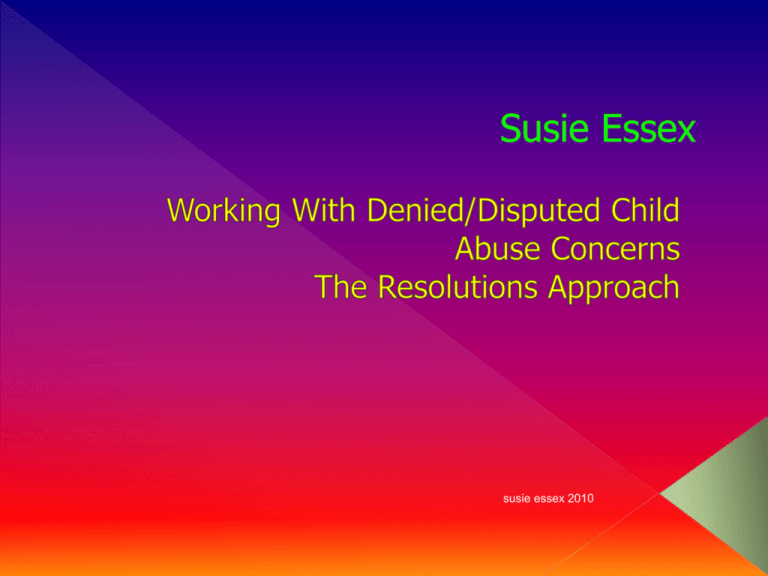
susie essex 2010 1.If this case were to have the perfect/ miracle outcome what would that look like? 2.List the main components for safety in that perfect/miracle, what would they be, what would you see family members doing. ( Think of the literature relevant to this area ie causes, grooming, risk factors, triggers etc and make into a positive doing things.). 3.If parents/carers were to ask “what do we need to do to show you our children are safe?” 4.List with specificity and detail what they would need to do. susie essex 2010 5.Of these safety factors which are most important? 6. Which do you think would be easiest to achieve (not necessarily the same as above) and what would you or a colleague need to do to help make it happen? 7. Of the remaining safety factors which would be most difficult to achieve, leave that for Susie to try in a role play. 8.Of the slightly easier ones what might you do differently that would have an impact on the family to help them move forward, how might you join them to create a context of combined problem solving to demonstrate safety factors. susie essex 2010 ‘It’s all about relationships. We are talking about dealing with people with problems, with painful stuff. You have to know someone, trust them. They must be reliable and be there for you if you are going to be able to talk about the things you don’t want to. The things that scare you.’ Parent Family Perspectives on safeguarding and relationships with children’s service The Children’s Commissioner for England, June 2010 susie essex 2010 Resolutions Risk Reduction Programme Child and Family Solutions susie essex 2010 1. Thinking about denial 2. Assessment restraints 3. Treatment / Resolutions / Future Safety susie essex 2010 According to Home Office statistics children under one year are 6 times at risk of being killed by a parent or carer as children aged 1 year to 5 years, and 11 times at risk compared to children aged 5 years to 16 years. The NSPCC estimates that 100 children a year are killed by their parents / carers. OFSTED reported that serious case reviews were initiated following the deaths of 81 children who died during 2007. Serious Case Review Summary 2005 highlighted the increased risk of suicide following longer term hidden abuse. John Gumbleton 2009 susie essex 2010 “There was a small group of cases of physical abuse, neglect and emotional abuse which presented special dilemmas to social workers. They were the ones where neither partner had admitted responsibility for abusing the child. …. without an admission the worker could feel uncertain about how to proceed.” Farmer E. & Owen M. Child Protection Practice: Private risks and public remedies, (1995) Pg 229 susie essex 2010 “Amongst the social workers a significant proportion regarded denial as a barrier to the formulation of a child protection plan (other than removal of the child) and in the development of partnership with families. They also believed acknowledgement to be a prerequisite to the commencement of any work towards rehabilitation.” Gumbleton & Lusk “Child Abuse: Rehabilitation without admission A new way forward” Family Law (Dec 1999) pg822 susie essex 2010 We can’t always identify the perpetrator/s We can’t be sure how the abuse happened We don’t know the precise antecedents to the abuse We can’t easily identify behavioural / contextual triggers We don’t know if the child’s carers are telling the truth It’s difficult to be certain what we’re dealing with Should we risk further harm to the child by attempting reunification? What if the child/young person wants to go home? What if the parents have another baby? susie essex 2010 Check back with the family....... Don’t be overly negative....... Make sure children have someone outside the family to talk to. Take what young people say seriously. I don’t like to be kept in the dark explain things more. Don’t get too involved – let the family try to solve it. “Don’t make assumptions” March 2011 www.childrenscommissioner.gov.uk Susie Essex 2011 3/17/2016 11 Participants’ ideas and experience of denial/disputed/discrepant explanation cases In two’s discuss your dilemma’s in cases of denial/dispute, be prepared to feedback one or two points. Eg. In a case of sexual abuse, if a parent said they had done the abuse and said they were very sorry, how much would you rely on this admission in planning your work , what might this parent say in other contexts? susie essex 2010 “The issue of ‘denial’ is a thorny and complicated one because there is no reliable way to distinguish accurately the behaviour of a parent who genuinely denies responsibility when wrongly suspected from that of a parent who denies in an attempt to avoid detection of actual culpability.” Dale et al “Fine Judgements” (2005) Pg 129 susie essex 2010 “In a similar way, the concept of ‘denial’ in investigations and assessments of serious suspicious physical injuries to infants is biased toward an assumption that parents are deliberately concealing conscious awareness of maltreatment, and that their refusal to confess is confirmatory evidence of this.” Dale et al “Fine Judgements” (2005) p140 susie essex 2010 They may be innocent/ it might be someone else Memory impairment due to drugs, alcohol or a neurological condition Shame /Guilt Family repercussions Social repercussions Criminal repercussions Child protection repercussions. All act as significant restraints to accepting responsibility- it might seem the stakes are too high. susie essex 2010 Recent Developments need to entertain greater complexity whilst maintaining the focus on Safety. “ .. the conclusions must take into account all aspects of the family's functioning and not focus exclusively on the presence or absence of denial, which is only one element of a much larger assessment.” Bentovim.A. in Reder and Lucey (eds) “Studies in the Assessment of Parenting” (2003) pg 255 susie essex 2010 The Three Domains Child Safeguarding and promoting welfare Family and Environmental Factors Susie Essex 2011 3/17/2016 17 Domestic violence/history of Domestic violence Drug / alcohol abuse/mis-use Mental health difficulties Learning Disabilities Parental denial/dispute Previous suspicious injuries Parents with history of abuse as children Unwillingness / inability to engage with professionals Isolation/sense of isolation from kinship and Community, None of these are predictors on their own, they are factors that need to be considered and discussed. susie essex 2010 An acknowledgement of the concerns, (or an understanding of agencies right to be concerned). A history of co-operation with professionals Willingness to accept services including therapeutic work to address concerns A viable support network/ kinship system Good Community links Good health A lack of other risk factors Employment and stable income Suitable Housing susie essex 2010 The way that workers approach families and how they engage with them is as important as the nature of the work undertaken. Therapists are aware that the therapeutic alliance counts for 40% of success and technique/mode of intervention for only11%. Co-operation based on the concerns is the key task. susie essex 2010 Professionals/ managers and Court Family/wider kinship Position of the worker/therapist susie essex 2010 They may be innocent/ it might be someone else Memory impairment due to drugs, alcohol or a neurological condition Shame /Guilt Family repercussions Social repercussions Criminal repercussions Child protection repercussions. Do we have a a legal and socialcontext that encourages responsibility. (Ian Leslie, Born Liars , 2011) Susie Essex 2011 3/17/2016 22 Building future safety around children Developing a working partnership based on the concerns Developing support networks based on the concerns Co-constructing safe increasing contact leading to overnight stays and a full return home( assessing risk at every stage) Words and pictures to explain the concerns for children and safety network Co-constructing family safety guidelines Working in the “similar but different” to look at literature and research informing concerns Focus on future communication, in particular, about difficult feelings and emotions. susie essex 2010 Reinforce and foster a sense of self agency with the possible non-abusing carer and/or key safe people in the childrens lives. Build on and/or strengthen the bond between the safe adults and the child/children Restrict and control the possible misuse of power of the alleged abuser Creating openess by involving helpful significant adults in keeping children safe, taking account of race, culture, religion, class and ability. susie essex 2010 “A recurrent theme for families is the reluctance of social services to recognise the value of extended family / kinship resources alongside ‘worst scenarios’ regarding the level of risks, and lack of resources for more constructive reunification programmes.” Dale et al “Fine Judgements” (2005) pg 94 susie essex 2010 susie essex 2010 “Failure to achieve this level of co-operation helps to explain why some children remain safe when others do not. The quality of the relationship between parents and professionals was found to be the main reason: a recurrence of abuse was less common in those families where some agreement had been reached between professionals and family members about the legitimacy of the enquiry and the solutions adopted.” DoH “Child Protection: Messages from Research” (1995) pg 45 susie essex 2010 Aspects of Future Safety 1. 2. 3. 4. 5. 6. 7. 8. Timescale, based on research Rota of active help to address key aspects of literature Significant people, know the concerns Safety network, prepared to be active and proactive over a reasonable time scale. Professional network prepared to be active Network members, give active support and a non-critical gaze Other practical issues, day care, meals, snacks, medicines, medical appointments etc All safety measures MUST be focussed on the Concerns. susie essex 2010 Alex and Kate Smith have two children, Jake 4 years and Chloe 8 months. Chloe is presented at hospital having allegedly been dropped by Alex whilst in his sole care. Medical examination reveals linear bruising to Chloe’s cheek, rib fractures of different ages and subdural haematomas, which the doctors think are non-accidental in origin. The family are not known to Social Services and the Health Visitor reports positively about the parenting and care of the children until this time. Jake is placed in foster care and Chloe joins him when she is allowed to leave hospital. Alex and Kate are allowed contact with the children five days per week supervised by social workers. The matter is put before the Court which has to decide what should happen to the children. Further assessments reveal no other concerns and both parents deny they have injured Chloe. susie essex 2010 Sarah Jim Kate Norman Alex Chloe Jake susie essex 2010 + A pre-school girl from Sunday School (Kelly), where Gerry helped as Leader, alleged that Gerry had sexually abused her. The matter was not taken to court but Social Services “substantiated” the allegations based on the detail of oral abuse in the girl’s report. As a result of this Social Services were concerned for the current and future safety of Gerry and Julia’s 3 year old daughter Emma. Julia’s sister Sharon and Julia’s mother have been helpful during the investigation. Susie Essex 2011 3/17/2016 31 + Sharon MGM Julia Gerry Kelly age 4 Emma age 3 Susie Essex 2011 3/17/2016 32 Summary 1. Preparation 2. Engagement 3. Words and Pictures 4. Family Safety Guidelines 5. Similar but different - role play 6 .Family Safety Plan 7. Future safety Communication and follow up. Child and Family Solutions susie essex 2010 Resolutions Programme Terms LP - the likely perpetrator LNAC - the likely non-abusing carer CPW - child protection worker FSG - Family Safety Guidelines Support Network - safe adults around the child Child and Family Solutions susie essex 2010 STAGE PURPOSE INVOLVING SESSIONS CONTACT ARRANGEMENTS PREPARATORY Reach agreement regarding participation with all parties fully understanding program. To proceed both professionals and parents must make commitments to participate. All professionals involved with the case. Parents, their advisors and key network people. 1 1 At this stage LPA or children will ideally be out of the home. ENGAGEMENT Engage with parents through understanding their experience, whilst continually exploring other perspectives. The resolutions practitioner positions themselves with maximum flexibility regarding the issues, whilst at all times focusing on the seriousness of the issues. Parents Social services worker to observe as agreed in stage one. 2 WORDS AND PICTURES Create agreed upon, age appropriate explanation regarding the allegations and/or convictions with the parents. Present to the children, then to the network. Developed with parents Presented to children with help of parents Presented to network with help of family 1 or 2 1 1 Professionally supervised contact between LPA and children. Following successful completion of each stage, the resolutions practitioner recommends increased contact, the statutory agency or court must decide on the changes Increase professionally supervised contact. Contact supervised by network begins. INTERIM FAMILY SAFETY GUIDLINES Identify in detail how family life will be arranged to demonstrate future safety for children and avoid further allegations/misunderstandings directed at suspected abuser. Initially created for contact arrangements but successively evolves as each step toward reunification is taken. Developed with likely LNAC, 1 Allows couple to overtly speak about the previously unspeakable as they role-play a couple where abuse is admitted. Aims to strengthen and educate LNAC, and focuses successively on perspectives of perpetrator, non-abusing caregiver, victim, other siblings and family members and the consequences as future grand parents. Educates re power dynamics, grooming cycles, perpetrator behaviours/tactics. This is NOT a process designed to gain an admission by stealth. Final plan, which documents future living arrangements to allow reunification. Plan includes consideration of future difficulties and a family safety object. Parents/caregivers SIMILAR-BUT-DIFFERENT ROLEPLAY FINAL FAMILY SAFETY PLAN Increase contact supervised by network. children and key support people. 4 First overnight stay. Increase overnight stays. Developed with likely LNAC, children and key support 2 2 people. Presented to LPA and network. FOLLOW-UP Monitor and refine implementation of Family Safety Plan. susie essex 2010 Everyone possible 2 Family reunification. Resolutions Programme 1. Preparation Purpose Reach agreement with all parties about their understanding of the program Persons Involved All professionals (1 session) Parents, advisors and key network members (1 session) Child and Family Solutions susie essex 2010 Contact Children (or the LP) will be out of the family home Resolutions Programme 2. Engagement Purpose Join with parents, understand their position whilst continually exploring other perspectives Persons Involved Parents. (1 or 2 sessions) The therapist positions self with maximum flexibility regarding the issues At all times maintain the seriousness of the issues Contact Supervised contact between LP and children Following successful completion of this stage, contact may be increased Statutory CPW observes all sessions for stages 2-6 Child and Family Solutions susie essex 2010 Statutory Agency or the Court must decide on changes Resolutions Programme 3. Words and Pictures Purpose Persons Involved Contact Create and agree Parents age-appropriate (1 or 2 sessions) explanation of the concerns and events Presented to the children Parents (1 session) Increase supervised contact Presented to the support network Family (1 session) Contact supervised by members of the support network Child and Family Solutions susie essex 2010 Resolutions Programme 4. Family Safety Guidelines Purpose Identify in detail how family life will be rearranged to demonstrate future safety for children Persons Involved Contact Parents, particularly the Increased contact LNAC, children and key supervised by support support network network members (2 sessions) Also helps to avoid further allegations directed at the LP Presented to LP and support network Family and support network (2 sessions) Child and Family Solutions susie essex 2010 First over-night stay Resolutions Programme 5. Similar but Different - role play Purpose Allows overt discussion of the previously ‘un-discussable’ Persons Involved Contact Parents and key members of the support network (3 to 5 sessions) Strengthen and educate the LNAC Not designed to get an admission of culpability Increase the number of over-night stays Child and Family Solutions susie essex 2010 Resolutions Programme 6. Family Safety Plan Purpose Final plan that documents the family’s future living arrangements. Persons Involved Contact LNAC, children and key members of the support network Includes consideration of the FSG, future difficulties and safety objectives Presented to LP and the wider audience Everybody (2 sessions) Child and Family Solutions susie essex 2010 Family reunification Resolutions Programme 7. Follow up Purpose Monitor the implementation of the Family Safety Plan, and review its operation in practice Persons Involved Everybody! Child and Family Solutions susie essex 2010 Contact How do we create a context for the work. How do we create an atmosphere of collaboration and cooperation. How do we bear in mind time as an important aspect of our work. M.Friedlander, V.Escudero,and L.Heatherington 2006 Chapters 10,11, and 12. “Do not.... Interpret rejection as ill will. Tell clients that their behaviour reflects dysfunction/psychopathology. Do...Explore family dynamics prompting reluctance. Thoroughly analyse the context to understand mistrust. Renegotiate the context and meaning of treatment to enhance all aspects of the alliance. susie essex 2010 What do they think today’s meeting is about? What have they been told and by whom? What are they hoping will come out of today’s meeting? Who is most concerned at present, what are they concerned about, who else is concerned and what are they concerned about? Who has been most helpful to date? Who or what has made most sense so far? susie essex 2010 Can you give me an example of how your family of origin dealt with, or overcame a difficulty or worry, how did they try to sort it out, whose help did they seek, and what ideas did they seem to find most helpful back then? How would you tackle that worry or difficulty now, what would you do the same what would you do differently, who would you seek out for help? How do worries currently get raised, talked about and resolved? Is talking about worries a helpful idea, if they are not talked about how do they get resolved? How would you like your children to remember you as parents, what do you hope they will be proudest/pleased about? susie essex 2010 What do they think their child X(however young) makes of what is happening? What makes them think she/he knows or thinks that? What has she/he been told? What questions has he/she asked or what has she/he seen or heard? What stories might he/she be telling himself? susie essex 2010 What do they think their child X(however young) makes of what is happening? What makes them think she/he knows or thinks that? What has she/he been told? What questions has he/she asked or what has she/he seen or heard? What stories might he/she be telling himself? susie essex 2010 Risk Reduction Future Focused Safety Work The empirical evidence is that lack of compliance, rather than denial, is the best indicator of re-abuse. (E Farmer, M Owen 1995) By leaving denial relatively unchallenged the Resolutions approach allows families to comply, in cooperation and partnership with agencies, about the future safety of their children. Partnership is based on Openness Respect susie essex 2010 Respect, in child protection based on Rigour and Grace Based on Not being rude Not getting in their way No gratuitous opinions Conversation with George Walker and Helen Young 1998 For further reading to understand the stance in a risk reduction program see chapter 3 in ‘Working with ‘Denied’ Child Abuse, The Resolutions Approach.’ Susie Essex and Andrew Turnell susie essex 2010 How to talk to them susie essex 2010 Listening carefully. Use their Language and where necessary run their words alongside professionals words. Interrupt only to underline strengths and resources. Be clear about own role, relationship to referrer, and limits to confidentiality. Coming in from the outer edge susie essex 2010 Following not leading. Curiosity about others views and opinions. A stance of curiosity and not knowing too quickly. Warming the context to ask about more difficult aspects. Allow them to tell their story, this is not agreeing but expressing interest in their perspective and ideas. Pictures to Underscore Listening. “So X would have seen you were surprised when the doctor called the ambulance.” susie essex 2010 Could we leave whether you did it or not to one side, up on a shelf so to speak? If the dispute was easy to resolve I guess it would have happened by now. Current research indicates, I can understand from the research and literature why they are worried but i do hear what you are saying , I have made a note of it here. Don’t be tempted to give a definitive position. susie essex 2010 The Relevance of the Judges Decision. susie essex 2010 susie essex 2010 End of day one do practice exercises susie essex 2010 Explanations for children as to what has happened in their family and why they may not be living at home, using drawing, play people etc. Undertaken with children and their parents and often with members of the support network present. susie essex 2010 STAGE PURPOSE INVOLVING SESSIONS CONTACT ARRANGEMENTS PREPARATORY Reach agreement regarding participation with all parties fully understanding program. To proceed susie essex 2010 Words and Pictures “Some adults who, despite having had very traumatic childhoods about which they can nevertheless tell coherent stories, are likely to have securely attached children. One important therapeutic implication of this finding is that it may be helpful, perhaps even transforming, to help the family to tell a more coherent story about its painful experiences, including its illnesses.” Byng-Hall, J. (1997) susie essex 2010 In threes think of the DVD family with injured baby Chloe. What might you expect someone to say to Jake about why he and his sister were going to Foster carers for a while? ( Think how you might use age appropriate language and some pictures) Who might explain to Jake, how might you help them explain? susie essex 2010 Fictitious Case Example for Fabricated or Induced Illness Family Members Mother: Mari 24 Father: Ralph 32 Jodie Hospital Dual Heritage 2nd Generation White UK born Autumn 2006 age 1 month Apnoea attack age 6 weeks Apnoea attack and rash age 3 months rash possible Apnoea Previous Child Death New Baby Due Boy Eli age 10 months in 2005 Easter 2008 The Safety Network Grandmother: dual heritage white UK and black British Great Uncle Frank and girlfriend Jo (Grandpa died 2005, white UK) Godmother: Connie Church friends: Pastor Mark and Cheryl etc…. susie essex 2010 Words and Pictures for Jodi - 1 In 2006, in the Winter, Jodi had a rash on her face. The doctor came to see Jodi. Grandma Sophie was there, as Mum had called her because they were so worried about Jodi. The doctor gave Mum and Dad a letter, saying ‘Please take Jodi to Hospital.’ susie essex 2010 Words and Pictures for Jodi - 2 Jodi went to the Hospital. Mummy told them Jodi seemed a bit floppy in the night. The doctors said ‘The rash might be a virus, but we need to check.’ Jodi stayed in Hospital. susie essex 2010 Words and Pictures for Jodi - 3 The doctors were worried as this was the third time in 3 months that Jodi had come to Hospital since she was born. The doctors talked to another doctor…..they thought the rash might be because someone had stopped Jodie breathing but they couldn’t be sure. …..then they talked to Social Services and other people. susie essex 2010 Words and Pictures for Jodi - 4 There was a big meeting - a Case Conference. The doctor said ‘We are very worried about Jodi’s rash. We think she might have been hurt’ The Case Conference decided to ask another doctor in London to see Jodi. susie essex 2010 Words and Pictures for Jodi - 5 In London, Mummy and Daddy said Jodi had one rash and had been to hospital lots because she was ill. The doctors seemed to say different things. Everyone was very worried. The Social Worker said this is confusing and worrying. I have to make sure Jodi is safe . We need a Judge to help sort it out. The Judge said she thought Jodi had been hurt when mummy was looking after her. She said she had to be sure Jodi would not be hurt again. susie essex 2010 Cover story for Jake? susie essex 2010 susie essex 2010 Helping families find ways of caring for their children that enhances their chances of staying safe and reduces the risks. The guidelines are co-constructed with parents, children (if of sufficient age and understanding), members of the support network and professionals. Difficulties become things to solve and create more safety not barriers to work. susie essex 2010 susie essex 2010 A pretend family is drawn up with the parents and we agree the basic family structure, ages, names etc. This pretend family will contain a child who has sustained non-accidental injuries of a similar level of seriousness to the real parents’ own child. In the pretend scenario one of the parents will have admitted harming the child. We explore the scenario from the perspective of the pretend parents, extended family, children and professionals. We also look into the future to consider the long term child protection implications. susie essex 2010 Resolutions Programme Similar but Different - role play The context is a different, hypothetical, family. The technique facilitates discussion of issues that the real family may consider to be too difficult; too close to home. Many details about the lifestyle of the 'Similar but Different' family may be different to those of the real one - but the abuse will be similar enough. Carers consider the point of view and feelings of the 'Similar but Different' family members: a child/victim, siblings, the abuser, the safer carer, the extended family. We consider life within the 'Similar but Different' family in five, ten, twenty, perhaps thirty years time, when the hypothetical carers are grandparents. By this means the long-term narrative of the 'Similar but Different' family attempts to provide a model of the future for the real parents. Child and Family Solutions susie essex 2010 General re-abuse rates are between 25 - 33% Follow up of the first 17 families worked with in Resolutions at Bristol NSPCC showed a 3 - 7% re-abuse rate Work with a similar number of families subsequently at NSPCC showed similar results Since being in private practice for the last 6 years we have had equal or better outcomes susie essex 2010 Resolutions Programme Statistical study: 17 families, 38 children* Before commencement of Resolutions Programme Sexual Abuse After Programme Physical Total Abuse Further abuse recorded Known or thought to have been abused 7 8 15 1 Thought to be at risk 18 5 23 0 *Gumbleton, 1997 Further abuse statistics gathered from Child Protection Registers, UK NSPCC and Social Services files Child and Family Solutions susie essex 2010 “Unknown proportions of parents who are ‘written off’ by social services can be worked with very productively when approached in specific ways. Many initially ‘unreasonable’ families can be influenced over time into a much more amenable and co-operative stance.” Dale et al “Fine Judgements” (2005) pg 197 susie essex 2010 “Although specialist skills need to be developed in working with serious cases of child abuse, many practitioners already have the fundamental skills necessary to undertake positive work with families. In many child protection cases, however, practitioners do not employ these skills because of the adversarial positions that develop between professionals and families. This becomes compounded where carers deny responsibility for abuse.” Gumbleton, J. “The reunification of children in serious child protection cases”, Context, (August 2004) pg 5 susie essex 2010 “… in principle, and in general child protection practice, the fact that a serious injury to an infant remains unexplained or in dispute is not, in itself, a barrier to some such children being returned home in the context of child protection plans involving appropriate monitoring, family support and therapeutic services.” Dale et al “Fine Judgements” (2005) p211 susie essex 2010 Visit to family one year later. Review words and pics. Review family safety guidelines. Do safety ladder, same paper and same colour pens, all into a shoe box. Any mark below halfway need to add one or two safety factors. susie essex 2010 “Denial” can be a significant risk factor but should not necessarily rule out reunification Professionals need to be open to all possibilities, including that the child’s carers are telling the truth The way that professionals approach families has an important bearing on outcomes for children Professionals should seek strengths and positives, as well as taking due note of the concerns We should actively seek out support networks Successful assessment and therapeutic work can be undertaken in “denial/disputed” cases susie essex 2010 susie essex 2010
